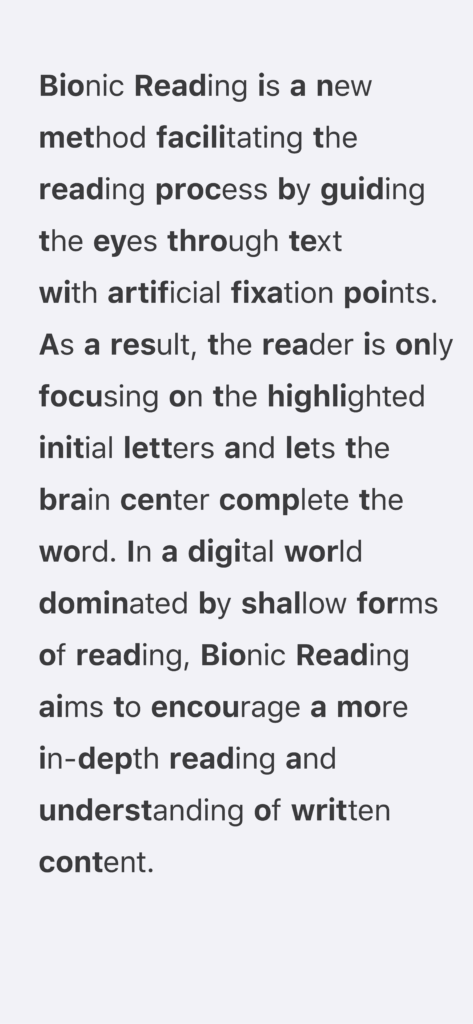Table of Contents
What is Bionic Reading?

Bionic reading has exploded virally this past week as a new way for people, especially those with ADHD and Dyslexia, to read more quickly. Bionic Reading bolds the first part of a word and leaves the rest of the word not bolded. According to the website, this novel reading method helps by “guiding the eyes through text with artificial fixation points” so that the reader does not have to read entire words.
According to the website, users can adjust the size of the fixation points that are bolded. This could help users find what amount of the word being bolded helps them to read more quickly.
Similarly, using a feature they have named “Saccade”, users can adjust how often words are bolded if they are overwhelmed by every word being bolded. This feature is named after the scientific term for how the eye changes fixation points when reading, seeming to “jump” from point to point on the page. Lastly, readers can also adjust the contrast between the bolded and not bolded sections with a feature called “Opacity”.
What is Bionic Reading Based on?
While the creator of Bionic reading does not give any specifics as to where his idea came from, his website claims that “just a few letters are enough to recognize whole words.” This claim is reminiscent of the phenomenon where the people can read words even if the letters are out of place as long as the first and last letters are correct. This is because the brain never actually reads every letter individually when reading, but uses generalized information about the shape and context of words to make inferences about what should be processed.
For example: The hmuan bairn deos not raed evrey letetr idnivaidully, but raeds wrods as a wohle. This trick of the brain shows that reading is a highly complex process that does not individually process every letter when reading, but makes assumptions based on word shape and error corrects as it goes along.
Is Bionic Reading Backed by Research?
Unfortunately, no research has been conducted so far showing that Bionic Reading is any faster than traditional reading. Some people do report feeling like they can read text more quickly this way, but there are many people who say that the out of place bolding of words actually slows down their reading pace as their brain is distracted trying to figure out why words are cut in half like this.
The creator of Bionic Reading, Renato Casutt, has a background in typographic design, but has no neuroscience credentials to help him explain his claims that this design helps readers’ brains to process text more efficiently. On his website, he does not back up any of his claims with research studies, nor does he claim to have worked with any neuroscientists to develop his method.
Is Bionic Reading a Scam?
This is not to say that Bionic Reading is a total scam, but schools should refrain from investing in it until more research has been conducted to verify the claims of the inventor of this new method. There are, however, ways to try Bionic Reading for free.
Teachers who are looking for new ways to try and help their students with ADHD and Dyslexia to focus better when reading could certainly check out the Chrome Extension or try converting a file into Bionic Reading mode with their free online converter.
While there is no research to back up Bionic Reading at this time, there is nothing harmful about trying it out. As long as schools do not invest money in this untested theory, there may be benefits for some individuals having some difficult texts converted into Bionic Reading if they feel that it helps them to focus better.
Speed Reading Methods Often Trade Speed for Comprehension.
Bionic Reading is not the first method developed to help readers read more quickly. Speed Reading methods and now even apps have been sold as a way for people to consume more content more quickly for many years.
Unfortunately, research has shown that “there is a trade-off between speed and accuracy” when using these speed reading methods. (Rayner et al.) Speed reading techniques often work by training users to skim texts rather than actually reading each word individually. While this may indeed allow readers to go through more content, they will not have the same level of understanding as when they take the time to read each word individually, internally vocalizing as they go along.
While it is not clear if Bionic Reading is a speed reading method, it does employ some of the same methods of trying to encourage readers to skip over portions of text with its bolding techniques. On the website, it claims that Bionic Reading is both “faster” and “more focused”. Perhaps Bionic Reading has unlocked a way unachievable with previous speed reading methods to not lose comprehension while simultaneously increasing speed. Only time and peer reviewed research studies will be able to tell.
Conclusion
Bionic Reading is a viral phenomenon that may end up revolutionizing how people read, or it may be a fad that dies out in a matter of weeks. Only through thorough, peer reviewed research will scientists be able to determine whether this method can truly help individuals to read more quickly.
This method will not only have to be tested on typical readers, but also be tested separately on individuals with ADHD and Dyslexia. Since people with ADHD and Dyslexia tend to read differently than typical readers, any results that show benefit for typical readers may not translate directly into this being a new beneficial intervention for people with reading difficulties.
This does not mean that Bionic Reading should not be tried with students, however. Because there are free options, teachers seeking new ways to help their students read more quickly can simply ask their students to upload a document to the free online converter and report back whether they found it helpful or not. This is something that can be done for all students, whether they have Dyslexia and/or ADHD or are typical readers simply trying to finish reading assignments more quickly.
References
Casutt, Renato. “Faster. Better. More Focused. Reading.”. Bionic Reading, 2022, https://bionic-reading.com/.
Rayner, Keith et al. “So Much To Read, So Little Time”. Psychological Science In The Public Interest, vol 17, no. 1, 2016, pp. 4-34. SAGE Publications, https://doi.org/10.1177/1529100615623267.



